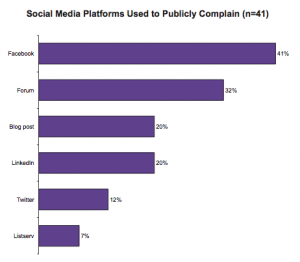Thumbs up—or down?

In other words, there’s no such thing as bad publicity.
True or false?
Queen’s University engineering student Justin Pho said it well when he wrote: “saying bad publicity improves a product’s image is like saying bullying builds character.”
Plus, with quick access to online review sites, it’s way too easy for a “bullied” consumer to tattle.
In an age where public opinion dominates—largely unfiltered, widely read and sometimes presented manifesto-style—it might be time to revisit some long-standing adages that no longer work.
How Do Scientists Make Themselves Heard?
We found in our recent report on customer service and technical support that only a small percentage of scientists take to social media platforms to publicly air complaints. But scientists also kvetch about under-performing products and poor service via private online conversations and of course, in the lab—each of which has its own way of going viral.
Of the 4% that report that they use social media platforms to publicly complain, the following depicts their preferred channels:

Customer Preferences, ©2011 BioInformatics LLC. Click to enlarge.
Only 4%? you might ask. Me too. I thought it would be higher. But reflect on your own usage of social media. How often do YOU post a complaint? Many of us rely on the squeaky wheels to do that for us.
All I want to do is read about it when I’m ready to buy.
One life scientist points out the obvious:
“…if you get comfortable with something doing it [as applies to social media usage] with Verizon Wireless then you’re more likely to do it with a life science supplier as well.”
Do you use social media to publicly complain about products? Let us know; leave a comment!




